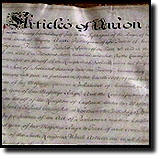
The Last Scottish Parliament
The Nature And Structure Of The Scottish Parliament
The Last Parliament of Scotland, 1703-1707
The Final Session
Anti-Unionism And Scottish Public Opinion
Anglo-Scottish relations were in a similar state of crisis. Increased English political management of Scottish affairs had led to greater criticism. One contemporary commentator observed that Scotland would `be no longer a province to England, or dance attendance at the door of an English court'. The Glencoe Massacre of 1692, sanctioned and implemented by the Crown in tandem with approval by Lowland elites, had intensified Highland-Lowland divisions.
The Revolution Settlement of 1689-90 had led to a more powerful Scottish Parliament. The two most powerful periods of the Scottish Parliament's existence can be defined as 1639-51 and 1689-1707. During the era of Covenanting control, the Scottish Parliament emerged as a mature political and institutional forum and was one of the most powerful assemblies in Europe. Drawing on the Scottish Constitutional Settlement of 1640-41, a programme of constitutional reform was renewed from 1689 onwards. The Scottish Parliament was by no means a `weak' institution when it was abolished in 1707.
By 1707 three estates were represented in Parliament; the nobility, commissioners of the shires and commissioners of the burghs. These were essentially the representatives of the landed aristocracy and mercantile elites. Shire and burgh representatives were elected, whilst the nobility could sit as part of their birthright. The Parliament was certainly an elite institution in terms of its social composition. In theory, 33 shire constituencies and 66 burgh constituencies were entitled to parliamentary representation by 1707. Burgh representation was based exclusively on the royal burghs. The representation of the clerical estate had been abolished at the Glorious Revolution as part of the Scottish Constitutional Settlement of 1689-90. This followed the triumph of Presbyterianism, following its persecution and attempted suppression during the Restoration era, and was in accordance with the traditional Presbyterian differentation between Church and State.
A major feature of British politics from 1702 to 1707 was the necessity of securing the Hanoverian Succession. The death of King William in 1702 resulted in the succession of Queen Anne to the crowns of England and Scotland. Anne's last surviving child had died in 1700 and the English Act of Settlement of 1701 had passed the English Succession over to the Protestant House of Hanover. Since it was unthinkable that Scotland and England should have separate monarchs, the securing of the Hanoverian Succession in Scotland became the primary objective in English strategic thinking towards Scotland. By 1703 the Anglo-Scottish dynastic union, the Union of the Crowns, was in crisis. The Scottish Parliament was pursuing an independent dynastic policy and an independent foreign policy.
The Scottish Act of Security of 1703-4 allowed for the Scottish Parliament to choose a different monarch to succeed to the Scottish crown from that of England, if it so wished. This meant that the Act allowed for the Scottish Parliament to initiate an independent foreign policy during an era of major European warfare, the War of the Spanish Succession. From the English political perspective, this opened up the possibility of the restoration of a Jacobite on the Scottish throne and a Franco-Scottish military rapprochement. Such an alignment could result in attacks from Scotland, France and Ireland. Hence the Scottish `problem' had to be neutralised and the Hanoverian Succession secured.
Several ministries, under English control, were formed in Scotland from 1703 to 1705 with the aim of securing the Hanoverian Succession but all were unsuccessful. The Treaty of Union can be traced to a series of events commencing in September 1705 which culminated in April 1707. As such, the Treaty of Union can be deemed a short-term political objective.
Previous attempts to secure a closer union between England and Scotland in 1689 and 1702-3 had failed. On 20 July 1705 a draft act for a treaty with England was moved in the Scottish Parliament. From this date on the key issue centred on who would negotiate such a treaty on behalf of the Scottish Parliament. In one of the most bizarre moments ever witnessed in Scottish history, the leader of the Scottish opposition, James, 4th Duke of Hamilton, stood up in Parliament on 1 September 1705 and moved that the Scottish negotiating commissioners should be named by Queen Anne. This opportunity was immediately seized on by the Court ministry to secure a vote. The session was adjourned on 14 September and all bar one of the Scottish commissioners nominated was pro-incorporation. Only Sir George Lockhart of Carnwath, a Jacobite, was anti-incorporationist and it is from his accounts that we know details of the actual negotiations for the Treaty of Union.
The negotiations began on 16 April 1706. Apart from the Scottish commissioners being unrepresentative of the wider Scottish political nation, each set of commissioners sat in separate rooms and their only communication was in writing. The principle of an incorporating union had been accepted by 25 April and thereafter the negotiations can be interpreted as a damage limitation exercise in securing the best possible deal for Scottish interests within a wider British settlement. Proposals for a federal union, which would have involved further constitutional reform in Scotland and would have retained the Scottish Parliament, were dismissed. The only acceptable political solution for the English negotiators was an incorporating union. The treaty had been agreed on by 23rd July and then the treaty went to the consideration of the Scottish Parliament which reconvened on 3rd October 1706.
Scotland In The Early Eighteenth Century
The Nature And Structure Of The Scottish Parliament
The Last Parliament of Scotland, 1703-1707
The Hanoverian Succession
The last Parliament of Scotland sat in four sessions between 1703 and 1707; 6 May-16 September 1703, 6 July-28 August 1704, 28 June-21 September 1705 and 3 October-25 March 1707.
The Alien Act
The English response, the Alien Act of 1705, threatened that all Scottish Estates held in England by non-residents were to be considered as alien property in law unless the Scottish Parliament had entered into treaty negotiations by Christmas Day 1705. In addition, an embargo was to be placed on major Scottish products being imported into England. This was at a time when it is estimated that almost 50% of Scottish exports, mainly linen and black cattle, were destined for English markets.
The Final Session

|
| The Articles of Union |
The Treaty Articles
The treaty consisted of 25 articles, 15 of which were economic in character. Each article was voted on separately and several clauses in articles were delegated to specialised subcommittees. Article 1 of the treaty was based on the political principle of an incorporating union and this was secured by a majority of 115 votes to 83 on 4th November. In order to minimalise the opposition of the Church of Scotland, an act was also passed in order to secure the Presbyterian establishment of the Church after which the Church stopped its open opposition, although hostility remained at lower levels of the clergy. The treaty as a whole was finally ratified on 16th January 1707 by a majority of 110 votes to 67.Parliament was adjourned on 25th March and the Estates were ordered to reconvene on 22nd April. No such meeting appears to have taken place and on 28th April the Scottish Parliament was dissolved by proclamation. The Treaty and Act of Union came into effect on 1st May 1707 having swiftly passed through both Houses of Parliament in England.
The ultimate securing of the treaty in the Scottish Parliament can be attributed more to the weakness and lack of cohesion between the various opposition groups in the House as opposed to the strength of pro-incorporationists, although there were Scottish parliamentarians who were committed in principle to the treaty. In fact the treaty was secured through the political management of the 25 votes of the loose political group known as the Squadrone Volante. The combined votes of the Court party with a majority of the Squadrone were sufficient to ensure the final passage of the treaty through the House. Many members of the Squadrone had invested heavily in the Darien Scheme and they believed that they would receive compensation for their losses; Article 14, the Eqivalent granted �398 085 10s to Scotland to offset future liability towards the English national debt. In essence, it was also used a means of compensation for investors in Darien.
Bribery and financial persuasion were also prevalent with �20 000 sterling (�240 000 Scots) being despatched to Scotland for distribution by the Earl of Glasgow. James Douglas, 2nd Duke of Queensberry, the Queen's Commissioner in Parliament received �12 325 sterling, the majority of the funding. The bulk of this funding was used in the payment of spies and agent provocateurs.


